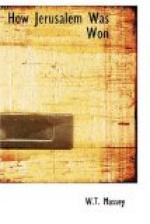To supply the Gaza front we called in aid a small system of light railways. From the railhead at Deir el Belah to the mouth of the wadi Ghuzze, and from that point along the line of the wadi to various places behind the line held by us, we had a total length of 21 kilometres of light railway. Before this railway got into full operation horses had begun to lose condition, and during the summer ammunition-column officers became very anxious about their horses. The light railway was almost everywhere within range of the enemy’s guns, and in some places it was unavoidably exposed, particularly where it ran on the banks of the wadi due south of Gaza. I recollect while the track was being laid speaking to an Australian in charge of a gang of natives preparing an earthwork, and asked why it was that a trench was dug before earth was piled up. He pointed to the hill of Ali Muntar, the most prominent feature in the enemy’s system, and said that from the Turks’ observation post on that eminence every movement of the labourers could be seen, and the men were often forced by gunfire to the refuge of the trenches.
When the railway was in running order trains had to run the gauntlet of shell-fire on this section on bright moonlight nights, and no camouflage could hide them. But they worked through in a marvellously orderly and efficient fashion, and on one day when our guns were hungry this little line carried 850 tons of ammunition to the batteries. The horses became fit and strong and were ready for the war to be carried into open country. In christening their tiny puffing locomotives the Tommy drivers showed their strong appreciation of their comrades on the sea, and the ‘Iron Duke’ and ‘Lion’ were always tuned up to haul a maximum load. But the pride of the engine yard was the ’Jerusalem Cuckoo’—some prophetic eye must have seen its future employment on the light line between Jerusalem and Ramallah—though in popularity it was run close by the ‘Bulfin-ch,’ a play upon the name of the Commander of the XXIst Corps, for which it did sterling service.
The Navy formed part of the picture as well. Some small steamers of 1000 to 1500 tons burden came up from Port Said to a little cove north of Belah to lighten the railway’s task. They anchored about 150 yards off shore and a crowd of boats passed backwards and forwards with stores. These were carried up the beach to trucks on a line connected with the supply depots, and if you wished to see a busy scene where slackers had no place the Belah beach gave it you. The Army tried all sorts of boatmen and labourers. There were Kroo boys who found the Mediterranean waters a comparative calm after the turbulent surf on their own West African shore. The Maltese were not a success. The Egyptians were, both here and almost everywhere else where their services were called for. The best of all the fellows on this beach, however, were the Raratongas from the Cook Islands, the islands from which the




